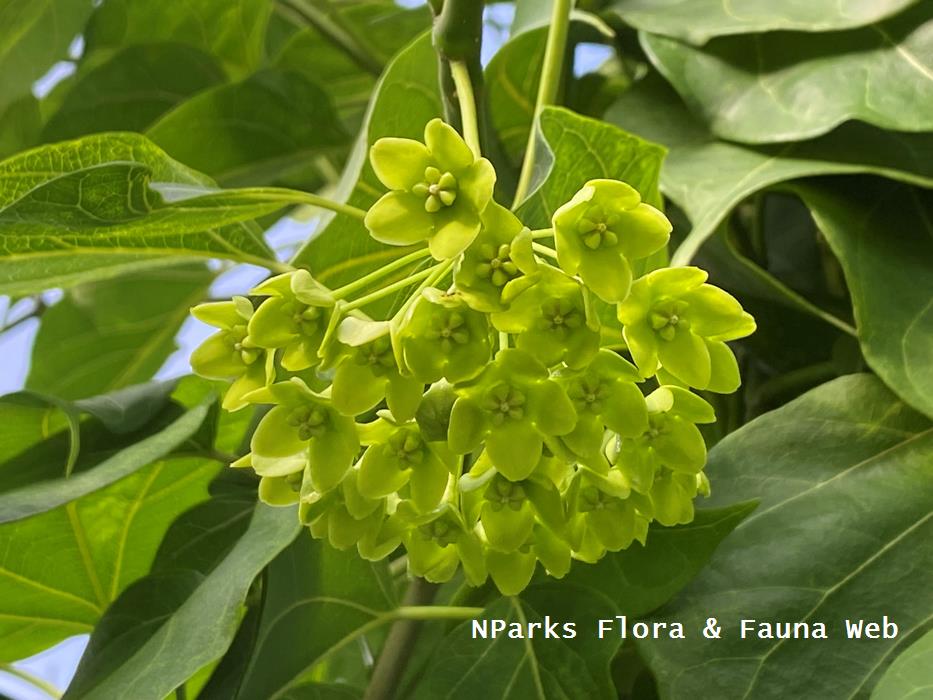
Back
Stephanotis volubilis (L.f.) S.Reuss, Liede & Meve
| Family Name: | Apocynaceae |
| Synonyms: | Dregea volubilis (L.fil.) Benth. |
| Common Name: | Giant Swallowart |
Woody climber has ornamental, greenish Hoya-like flowers. It is used as a medicinal plant in India to treat a variety of illnesses including fever, cough, asthma and skin sores.
Name
Classifications and Characteristics
| Plant Division | Angiosperms (Flowering Seed Plants) (Dicotyledon) |
|---|---|
| Plant Growth Form | Climber |
| Lifespan (in Singapore) | Perennial |
| Mode of Nutrition | Autotrophic |
| Maximum Height | 9 m |
Biogeography
| Native Distribution | Northeastern Pakistan to Southern China, Peninsular Malaysia, Indonesia |
|---|---|
| Native Habitat | Terrestrial (Primary Rainforest) |
| Preferred Climate Zone | Tropical |
| Local Conservation Status | Non-native (Horticultural / Cultivated Only) |
| CITES Protection | False |
Description and Ethnobotany
| Growth Form | Woody climber. |
|---|---|
| Foliage | Leaves are egg-shaped to approximately round or heart-shaped with a long pointed tip (7.6 - 15.2 cm long, 5 - 10 cm wide). They occur in pairs (opposite leaf arrangement) and have a leathery, hairless texture. |
| Flowers | Green to yellowish green, fragrant flowers (1.3 cm wide) occur in an axillary cyme inflorescence. |
| Fruit | Dry fruit known as a follice is lance-shaped with ribbed surface (2.5 - 3.8 cm x 1.9 cm). Seeds are smooth, glossy and elliptic, attached to white tufts of hairs |
| Habitat | Occurs in moist deciduous forests and plains. |
| Ethnobotanical Uses | Edible Plant Parts : Edible Leaves Medicinal: Traditional Medicinal Uses In Myanmar traditional medicine, Stephanotis volubilis leaves are applied externally on sores and boils to promote healing by reducing pus and swelling. <1> It is important to note that some therapeutic effects from traditional medicinal uses of plants are not currently supported or verified by scientific research.
Others: The leaf extract has compounds that kill mosquito larva. <2> |
Landscaping Features
| Desirable Plant Features | Fragrant (Flowers) |
|---|---|
| Thematic Landscaping | Fragrant / Aromatherapy Garden |
Plant Care and Propagation
| Light Preference | Full Sun |
|---|---|
| Water Preference | Moderate Water |
Foliar
| Mature Foliage Colour(s) | Green |
|---|---|
| Mature Foliage Texture(s) | Leathery |
| Foliar Type | Simple / Unifoliate |
| Foliar Arrangement Along Stem | Opposite |
| Foliar Attachment to Stem | Petiolate |
| Foliar Shape(s) | Non-Palm Foliage (Ovate, Cordate) |
| Foliar Venation | Pinnate / Net |
| Foliar Margin | Entire |
| Foliar Apex - Tip | Acuminate |
| Foliar Base | Cordate |
Floral (Angiosperm)
| Flower & Plant Sexuality | Bisexual Flowers |
| Flower Colour(s) | Green |
|---|---|
| Flower Grouping | Cluster / Inflorescence |
| Flower Location | Axillary |
| Flower Symmetry | Radial |
| Individual Flower Shape | Stellate / Star-shaped |
| Inflorescence Type | Cyme |
Fruit, Seed and Spore
| Mature Fruit Texture(s) | Wrinkled |
|---|---|
| Fruit Classification | Simple Fruit |
| Fruit Type | Dehiscent Dry Fruit , Follicle |
References
| References | <1> DeFilipps, R.A. & Krupnick, G.A. (2018). The medicinal plants of Myanmar. Phytokeys 102: 1–341. <2> Hossain, E., Rawani, A., Chandra, G., Mandal, S.C. & Gupta, J.K. (2011). Larvicidal activity of Dregea volubilis and Bombax malabaricum leaf extracts against the filarial vector Culex quinquefasciatus. Asian Pacific Journal of Tropical Medicine 4(6): 436–441. |
|---|
Image Repository
Others
| Master ID | 34497 |
|---|---|
| Species ID | 8910 |
| Flora Disclaimer | The information in this website has been compiled from reliable sources, such as reference works on medicinal plants. It is not a substitute for medical advice or treatment and NParks does not purport to provide any medical advice. Readers should always consult his/her physician before using or consuming a plant for medicinal purposes. |


